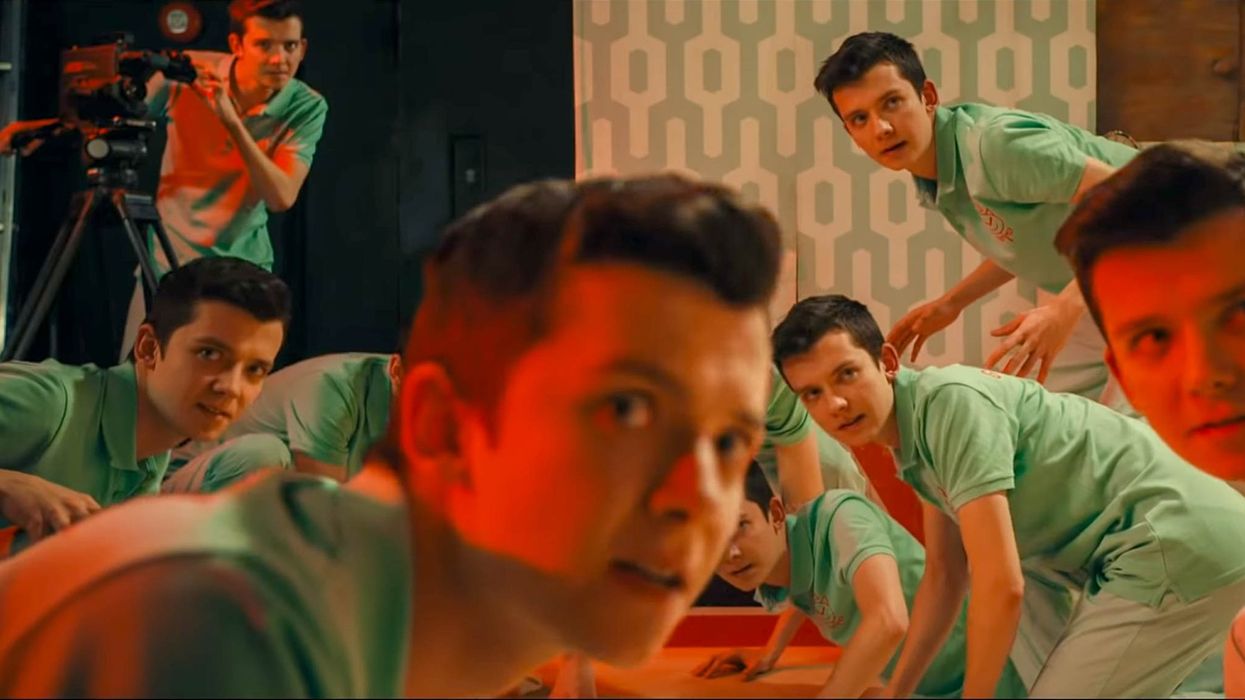7 Tips for Cloning Asa Butterfield with the Filmmakers of ‘Right Place, Wrong Tim’
Creative filmmaking trumps excessive editing with tips from these SXSW Midnight Short filmmakers.

It’s a problem as old as time itself: how does one clone the likes of Asa Butterfield? It’s a paradox even to consider cinematically faking the cloning process of the esteemed actor best known for his roles in Hugo, Ender’s Game and The Boy in the Striped Pajamas. Yet, through the magic of film, framing, camera movement and up to four stunt doubles, SXSW filmmakers have finally solved the riddle.
Writer / Director Eros Vlahos and Director of Photography Edgar Dubrovskiy sat down with No Film School at Austin, Texas to talk about the Midnight Short “Right Place, Wrong Tim” and how the duo was able to crack it in what is perhaps one of the most wheels-off meta-sitcom episodes in the history of the public-service television.
1) You Have to Design From the Script up
Eros Vlahos: “From a filmmaking point of view when you go into a difficult project like this your script has to be your roadmap. And even before that I had a drawing of what the set would look like, which introduced the logic of how the clones would enter the set. And that’s how you achieve this on a small budget because you’ll know where they’ll be for the framing of each shot."
2) Camera Tricks and Perspective
Edgar Dubrovskiy: “Most of our camera tricks involved using doubles. We worked hard to find creative ways to cover as much of the frame with them as possible using a hand or a leg where logically there should be more people. We also used a “high-tech” C-stand which we rigged with gaff tape to represent Asa’s height for matching eyelines across the doubles so every time he’s looking at them it’d look right.”
3) Use a Ton of Camera Movement
Eros Vlahos: “I’d almost say that almost every camera movement you see in the short was a spot that we were using to hide a cut. There’s a section where we perform an entire 360-degree sequence that whips around hiding over six cuts between a double killing a double, back to Asa, back to the audience, back to Asa, etc…”
4) Create Real Time
Edgar Dubrovskiy: “We wanted to embrace real time and have as much as a continuous narrative as possible so it feels like it’s actually happening. We only did tripod to tripod shots in the “sitcom world” to create distinction of what is reality. From a filmmaking point of view that was very cost effective as saves on VFX.”
5) You Don’t Need Great Doubles
Eros Vlahos: “We had three doubles who looked NOTHING like Asa, which meant we had to work even harder in the composition to keep them out of frame. The best double worked in the office at the theatre. He became our “chief clone”. We could only afford one VFX shot (which shows 10 or 12) but all the others were camera tricks.”
6) Find the Camera Setup to Ground the Story
Edgar Dubrovskiy: “At the beginning of the film, we shot on an old Hi-8 camera because we wanted it to look like it was an old British sitcom. From there though, to create a tonal break as the reality and space begins to change, we went with the Alexa Mini in the 2:35:1 aspect ratio with the more cinematic look and lighting, but we still weren’t afraid to cut back and forth between the two as the characters’ discomfort with the story grew.”
7) Make Sure Your Character is Iconic (like Asa)
Eros Vlahos: “Perhaps my biggest piece of advice for cloning Asa Butterfield, or anyone for that matter, for a film is that you’ll want your create an iconic and easy character to recognize. We were able to keep Asa’s character easily recognizable by giving him solid shade clothing and slicked back hair, which helped with working matching the stunt doubles. In a soft focus shot, they look like him (although they clearly didn’t look anything like him). If you’re trying to do this with a mundane character in a mundane set, the effect just really won’t hit.”
For more, see our ongoing list of coverage of the coverage of the 2019 Sundance Film Festival.
No Film School's podcast and editorial coverage of the 2019 Sundance Film Festival is sponsored by RODE Microphones and Blackmagic Design.














